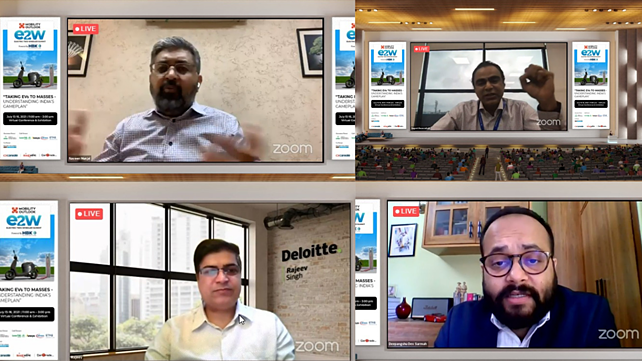
This is absolutely the best time for the electric vehicle (EV) industry, especially the e2W, as both the Central and several state governments are pushing in the same direction, Naveen Munjal, MD, Hero Electric, has said.
Delivering the inaugural address at the two-day Electric Two-Wheeler Summit (e2W), with the theme - Taking EVs to masses, understanding India’s gameplan, organised by Mobility Outlook, Munjal said, the EV policies (referring to FAME II and PLI ) of India are the best in the world as they cover the entire ecosystem. Now it is up to the industry players to grow this market.
Munjal said e2W will be 20% of the ICE market in the next five years, reaching about four million units. The factors that support the growth include falling vehicle prices and rising petrol prices that increase the total cost of ownership.
For instance, a 50-km commute needs about a litre of petrol that cost over INR 100 while an EV can cover the same distance with about 1.5 units of electricity, which costs about INR 12, he pointed out. The gap will be even wider with the dropping battery cost, localisation and innovation.
'This year is going to be remembered as a catapult year,' for the EV industry, he said and added that it will witness exponential growth in the future.
In his keynote address of the virtual event, participated by close to 3,300 delegates, Nagesh Basavanhalli, MD & CEO, Greaves Cotton, said that due to immense benefits, the EVs gave the same livelihood to many after migrating from cities to their natives during the pandemic, bringing development at the grassroots level. According to him, the five key enablers are government policies, changing consumer behaviour, smart cities that drive road infra improvement, sustainability, start-up ecosystem. He said India has the third-largest start-up ecosystem in the world. 'Things are moving (in the right direction) as we speak,' he said.
Awareness on EVs, finance availability and supply chain are some of the challenges, he said. However, he gave the direction to overcome these issues. While technology is improving and charging stations growing, finance can be addressed through financial engineering. Besides, battery-as-a-service and different kinds of business models can be looked at.
He reiterated the need for India to set up global R&D, attracting the local and global talent to fast-track capability development.
'India's EV opportunity is a chance to re-skill, re-tool and re-orient the sector, that has been very important to the nation's GDP; but the implementation should be undertaking in a collaborative and time-specified manner with regulatory, technology and economic clarity,' Basavanhalli added.
Giving the analysts' perspective, Rajeev Singh, Partner and Automotive Sector Leader, Deloitte, said electrification itself will be one of the levers for the growth of the 2W segment; according to the recently conducted survey, the reason for EV adoption is lower operating cost and better driving experience. He listed out charging infrastructure, safety, acquisition cost and range anxiety as concerns.
According to him, the change in demographics and growing b2b segment are stimulants for the segment to grow. The b2b segment could be a significant growth driver the moment they find that it makes a lot of business sense for them to move from ICE to electric. The typical driving range of this customer segment and the lower utilisation during nights makes sense for them to go for EVs.
Localisation of the value chain is essential for the segment to grow, he said. Having control on the value chain from a supply disruption or risk perspective is going to be crucial; when the numbers are small, the risks are not seen, but when the numbers exponentially grow, the risks will also get accentuated multiple times if the back-end of the value chain is not under check.
For imports, technology tie-ups and right commitments from the back-end are crucial, he said. There will be a lot of play for OEMs on the front-end in terms of creating charging infrastructure, battery swapping, etc. There are many avenues for the OEM to capture the profit pool. 'This is the time for OEMs to think differently in terms of what profit pools they would like to participate in.' In the case of ICE, the profit pool is distributed across the entire value chain. The OEMs can expand their profit pools in which they would like to play as the industry grows in the future,' Singh added.
Deepangshu Dev Sarmah, Editor, Mobility Outlook, welcomed the gathering.
The event also had a virtual exhibition participated by ten companies – Ampere, Ansys, Ather, Bgauss, ETAS, HBK, Lucas TVS, Okinawa, Puer EV and Saietta VNA.